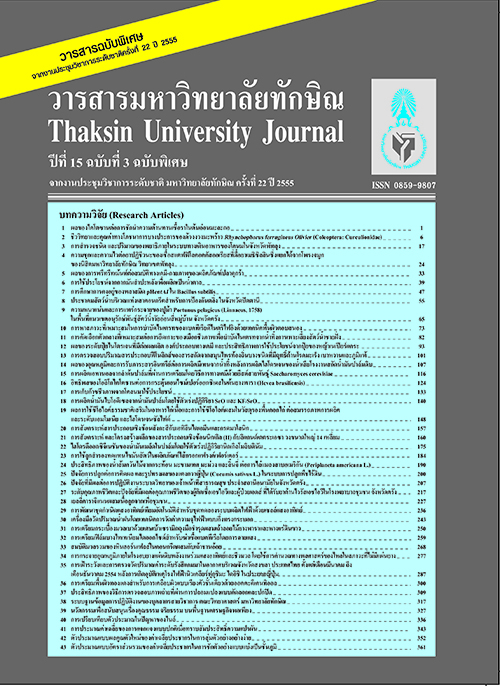ไฮโดรดีออกซิจีเนชันของน้ำมันเมล็ดในปาล์มโดยใช้ตัวเร่งปฏิกิริยานิกเกิลโมลิบดินัม
Main Article Content
Abstract
งานวิจัยนี้เป็นการศึกษาปฏิกิริยาไฮโดรดีออกซิจีเนชันของน้ำมันเมล็ดในปาล์มทำในเครื่องปฏิกรณ์แบบ เบดนิ่งที่มีการไหลอย่างต่อเนื่องโดยใช้ตัวเร่งปฏิกิริยานิกเกิลโมลิบดีนัมบนตัวรองรับอลูมิเนียมออกไซด์ ทำการ ทดลองที่อุณหภูมิ 300 320 340 360 และ 380 องศาเซลเซียส ที่ความดัน 450 750 และ 1,050 ปอนด์ต่อตารางนิ้ว ความเร็วเชิงสเปซของของเหลว 1.0 ต่อชั่วโมง เพื่อศึกษาปฏิกิริยาไฮโดรดีออกซิจีเนชัน และปฏิกิริยาข้างเคียงคือ ปฏิกิริยาการแตกตัวของไตรกลีเซอไรด์ ปฏิกิริยาดีคาร์บอนิลเลชัลและปฏิกิริยาดีคาร์บอกซิเลชัน จากการศึกษาพบว่า อุณหภูมิและความดันมีผลต่อการเกิดปฏิกิริยา เนื่องจากผลการวิเคราะห์การทดลองที่อุณหภูมิสูงกว่า 340 องศาเซลเซียสจะเกิดปฏิกิริยาไฮโดรดีออกซิจีเนชันได้ดีกว่าที่อุณหภูมิ 300 และ 320 องศาเซลเซียส และที่ความดัน 750 และ 1,050 ปอนด์ต่อตารางนิ้ว สามารถเกิดปฏิกิริยาได้ดีกว่าที่ความดัน 450 ปอนด์ต่อตารางนิ้ว เพราะมี ปริมาณก๊าซคาร์บอนไดออกไซด์ และปริมาณกรดไขมันอิสระต่ำกว่า แต่มีปริมาณน้ำและค่าร้อยละของสารประกอบ อัลเคนสูงกว่า
The research of this study is to investigate hydrodeoxygenation of palm kernel oil using nickel molybdenum on alumina supported catalyst. The experiments were conducted in a fixed bed continuous-flow reactor. The temperatures were varied at 300, 320, 340, 360 and 380 ºC. Pressures were varied at 450, 750 and 1,050 psig. Liquid hourly space velocity (LHSV) was 1.0 h-1. The results showed that decarboxylation decarbonylation and decomposition reactions are important side reaction occured along with hydrodeoxygenation of palm kernel oil. The results show that the reaction occurs well at high temperature (340-360 oC) because of the high conversion of hydrodeoxygenation reaction and no side reactions. At high pressure (750 and1050 psig), the reaction occurs better than the one at low pressure(450 psig). The reaction at low pressure was found that there is high amount of free fatty acid and low amount of alkanes.


